The history of the sewing machine is one littered with accusations, failed attempts and some serious scandal. From narrowly escaping death to patent law suits, it’s an interesting story that demonstrates the seam-ingly humble sewing machine ruffled more than a few feathers in its lifetime.
A 20,000 year old art form
The history of the sewing machine wouldn’t exist without the artistry of hand sewing. People started sewing by hand some 20,000 years ago, where the first needles were made from bones or animal horns and the thread made from animal sinew. Our inventive instinct explains the natural progression to want to improve sewing techniques and make it less laborious. Cue the Industrial Revolution in the 18th Century Europe, where the need to decrease manual sewing in factories became paramount.
1755: The First Patent
Charles Weisenthal, a German man, was issued a British patent for a “needle that is designed for a machine.” There’s no description in Weisenthal’s patent of any mechanical machine, but it shows there was a need for such an invention.
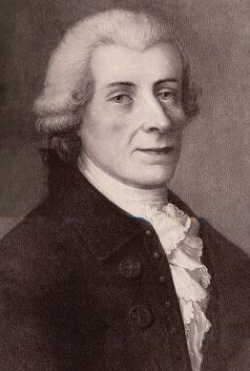
1790: The First Detailed Design
The history of the sewing machine essentially starts here. A cabinet maker from England named Thomas Saint designed the first sewing machine of its kind. The patent described a machine powered with a hand crank to be used for leather and canvas. Nobody knows if Saint built a prototype, but in 1874, English engineer, William Newton Wilson found the patent drawings. They were so detailed, he built a replica, proving that it did work.
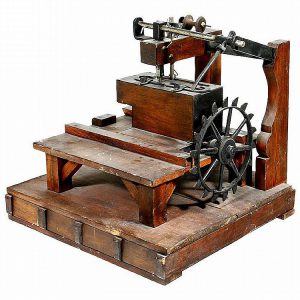
Early 18th Century: Many Attempts, Many Fails
It’s worth mentioning that all attempts of designing a sewing machine before the first successful one, all moved the needle side to side and were powered with a winding handle.
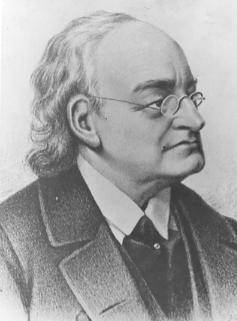
- 1810: Balthasar Krems invents an automatic machine for sewing caps. He didn’t patent his design but it didn’t work anyway.
- 1814: An Austrian tailor, Josef Madersperger, was issued a patent in 1814. He was persistent, attempting several different designs, but all were unsuccessful.
- 1818: John Adams Doge and John Knowles invent America’s first sewing machine, but it could only sew a few bits of fabric before breaking.
1830: The First Successful Sewing Machine
Joy! 40 years since Thomas Saint first drew and described a machine for sewing, we finally have a functioning sewing machine. Barthelemy Thimonnier, a French tailor, invented a machine that used a hooked needle and one thread, creating a chain stitch.
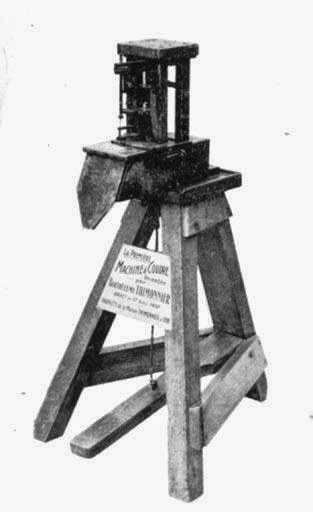
1830: A Riot & Near Death Experience
After the successful patent, Thimonnier opened the world’s first machine based clothing manufacturing company. His job was to create uniforms for the French Army. But when other French tailors got wind of his invention, they weren’t too pleased. They feared his machine would result in their unemployment so they burnt down his factory while he was still inside. Never take your sewing machine for granted ever again; this guy almost died for it.
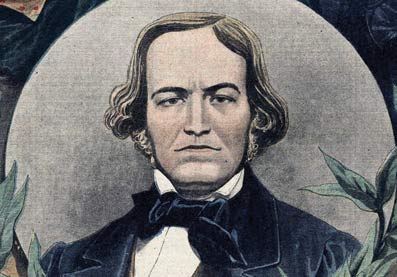
1834: Morals Over Money
This is an example of sticking true to your beliefs. Walter Hunt created America’s first functioning sewing machine, but he had second thoughts. Hunt thought such a machine would cause unemployment for many, so he didn’t bother to patent the design. Now you see where things are going to get messy.
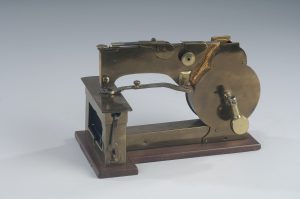
1844: A Lost Patent
The sewing machines we’ve seen so far are all made up of disjointed elements, with nothing really working together. In 1844, English inventor John Fisher designed a sewing machine that would eliminate this disparity between the moving parts. However, a botched filing job at the Patent Office resulted in his patent getting lost, so he never received any recognition.
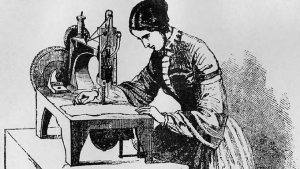
1845: Elias Howe & the Lockstitch
Elias Howe from America invents a sewing machine that resembles Fisher’s, with some tweaks and adjustments. His patent was to invent “a process that uses thread from 2 different sources.” His machine has a needle with an eye at the point, which goes through the fabric creating a loop on the reverse, a shuttle on a track that slips the second thread through the loop, creating what is called the lockstitch.
He struggled to market his design, so he took the plunge and sailed to England. After a lengthy stay, he returned to America only to find others had copied his lockstitch mechanism. One of those was an Isaac Merritt Singer.
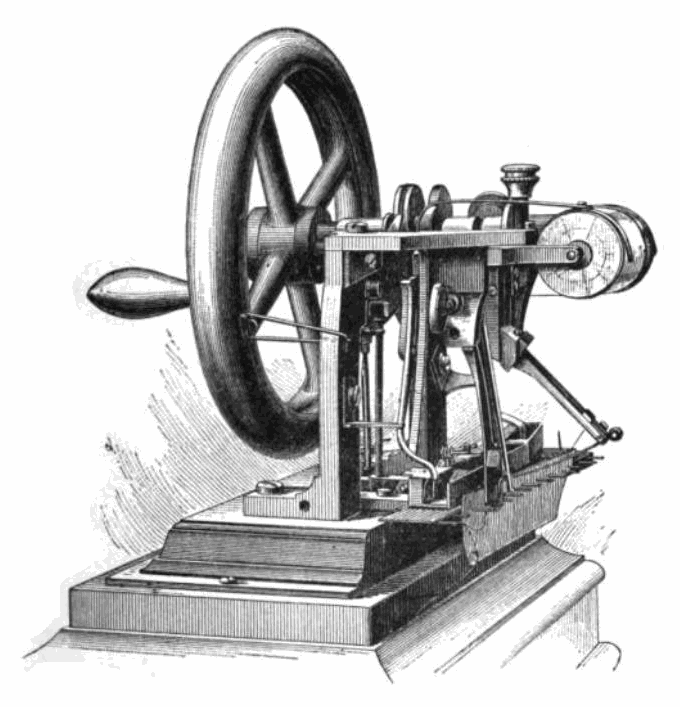
1851: Introducing Isaac Singer
Isaac Merritt Singer is one of the most well-known sewing machine manufacturers, building an empire that is still going today. His iconic Singer sewing machines are beautifully ornate and somewhat legendary. He developed the first version of our modern day sewing machine, with a foot pedal and the up-and-down needle. He was also inspired by elements from the Howe, Hunt and Thimonnier inventions, causing Howe to file a lawsuit.
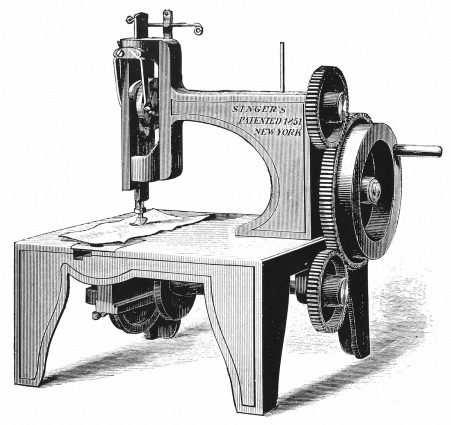
1854: A Real Stitch Up
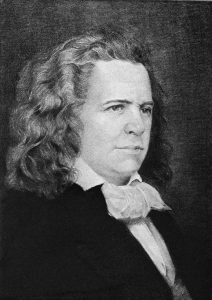
Elias Howe took Singer to court for Patent Infringement, where he defended his case and won. Isaac Singer tried to refer back to Walter Hunt’s design, expressing that Howe infringed upon his idea. Unfortunately for Singer, this didn’t have any impact at all. The lack of patent on Hunt’s design meant it was intellectual property for anybody to use.
What’s interesting is that if John Fisher’s patent hadn’t have been filed wrong in the Patent Office, he too would have been involved in the law suit as both Howe and Singer’s designs were almost identical to the one Fisher created.
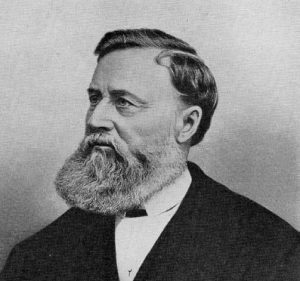
Consequently, Singer was forced to pay a lump sum of patent royalties to Howe, as well as giving him a share in the I.M. Singer & Co profits.
Despite all the allegations, drama and legal disputes, Howe and Singer both died multimillionaires, and each of these pioneering inventors gave the world the sewing machine. Without the early failed attempts and sheer persistence to create something that would relieve the women and factory workers of long, perilous hours, who knows what our clothing manufacturing industry would look like today. The history of the sewing machine is a complicated one, and as a result, many enthusiasts still debate who can claim the title of the real inventor. Our stance? We’re just glad we still don’t have to use animal sinew and bones.

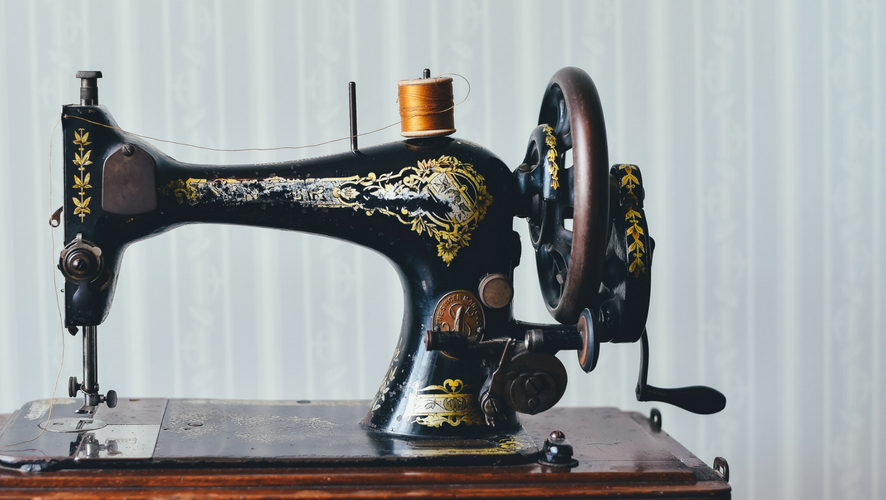
i was very pleased with this infomation about my be loved sewing, ever sincei was a little girl i had always thought: where did my sweing machine come from. nw i knw thank yiu CONTRADo.com for fullifng my dream
i agree very very very strongly, i too have always wanted to know what the stuff about the sewing machine thx golly pally
xoxo~pinapple wily
Dear Stephanie
Could you please tell me anything you know about the singer machine you have pictured at the beginning of this discussion entitled ” Learn the basics History of the Sewing Machine” on June 26, 2019? I just bought the same model at an antique shop which has has had the hand crank removed and an “Economy Universal Motor” (60 Volts) and a light attached. The tag indicates it’s a Model 44 and it has 2 patent dates listed 1910 and 1911. It came in a lovely old round wooden carry case. Any thoughts? Many thanks for your attention!
Hello my son brought me a old singer mofle EF116984 Can any one tell me how to find out inf about it like what year it’s from
Singer Co website has an antique section where you supply the machine’s serial (not model) number and their database will provide info. I researched a Featherweight prior to purchasing… serial # was bogus, machine a fake and seller took the $35 I offered. (1/10th of asking price.) Twin granddaughters are having a blast learning how to sew ; )
I have a singer sewing machine #AE337093 can you tell me how much it is worth wit the cabin
At about eights years of age I learned to sew on a Singer sewing machine. Our Singer has a black and gold design, sits on a wood table and has a large pedal and wheel under the table.
It was 1978 and I had been watching my mother sew. My mother never realized I watched and absorbed everything. One day I took over, while she was not looking, and I began sewing away. My first project was two pillow cases and a flat sheet with a trim design on both. My mother was amazed!
Reading the history of the sewing machine brought back so many memories! Thank you Contrado for this bit of History! ❤
I love you story! From a very early age, I watched my mom sew many garments, lined drapes, etc. She was very patient with me. Later in life I realized her love for it and desire to pass that knowledge on. It’s like my “nerve pill”.for relaxing in a hectic world!
Amen! Jenny
I started sewing with thread and needle on the floor beside my grandmother. Then at 12 started using the machine (Singer 301). Sewing creates a mental vacation for me. When I sit at the machine all worries and stresses evaporate. I’m embarrassed to say I own 3 singers and 4 Pfaffs.
Do you thing that too many? I just bought a treadle 66-16. LOL
Do you know of any sewing machine reference books?
I have a very old swing machine.i think it’s make in last 18 century ore in 1900.
I have a sewing machine with only the attachment stating the following:
Patented
Dec. 5, 1882
Sept. 22, 1885
July 19, 1887
Aug 21. 1888
Jan 13, 1891
I have a Singer treadle sewing machine with the serial No F8216443 think 1900 I am looking for a manual any help greatly appreciated
Hi Gloria. Your machine was one of the thousands made at the factory in Kilbowie, Clydebank, Glasgow, Scotland during the last half of 1910. It’s a class 16K machine.
Kilbowie used to be a farming village and Clydebank a town on the banks of the Clyde, a river famous for the shipyards in Glasgow. Now of course both Clydebank and Kilbowie are parts of Glasgow.
There’s a wikipedia article on Singer that talks about the Kilbowie factory. It was enormously productive at the time–13,000 machines a week and they still couldn’t keep up with demand.
A most interesting history. So glad it was told with such vivid description. A fine job, indeed.
I entered a serial no. G8844389 and it says made 1921 nut that is all i know. I was wondering what the model Is and if i can get how take it a part and clean it. Also where I can find a cover where the bib on goes.
Thank you,
MARY
Hi Mary. Your machine seems to be a model 27 and was made on 30 December 1910 in Quebec at the Saint-Jean-sur-Richelieu factory. Hope that helps!
–Margaret
Wonderful history lesson, thank you.
I have a old sewing machine inherited – the name on it is Anderson – is this a subsidiary of Singer and any idea how old? Any info would be so appreciated . There is a number that I can read on it 5107120. Thank you .
I would like to find out about this old Singer sewing machine I have. A picture is included. It comes with a wooden carrying case. It also has this number on it, but when I do a search nothing comes up. ( JCO39491). Please, if you could give me any information on this machine. I can be reached at 705.896.9323 or scottishsweetie59@gmail.
Thank you
Ms E.McRae
I have the machine invented by Elisa Howl it is his first machine that worked. It’s so intriguing to look at. My machine has Eliza house medallion probably the size of a half dollar coin in bedded in the machine plus it is inlaid with real pearl. I am wondering what the value of my machine is. HOWL is on the foot plate. And the top of the machine The cabinet folds down flat like a desk. I would appreciate any information that you could share with me I am told that there was only one more in existence and it’s in the Smithsonian in Washington DC. Any information would be appreciated.
Awesome! Helped me with my school project 🙂
It also helped me with my school project.this project is two grade and thank to you I will get 2 100%
Hi guys I got a bunch of old singer machines I’m trying to get rid of them if anyone is interested please contact me at the below Gmail thank you have a nice day
I have a Singer 301A and under the bottom left is a plate with number 170027 Simanco, USA. Is this a 1952 Singer or a fake? Reading on internet it was stated that Singer lost some of their files in a fire and lost unknown serial numbers.
Theres a scandal that singer rather than sell spare parts to fix machines would buy them back to destroy them to force sales of new machines. I seen this in a documentary 20+ years ago and would love to find the details, I may be miss remembering it, it may have been a rival corporation?
Simanco stands for SIngerMANufacturingCOmpany
To my knowledge, that IS the company that became famous for manufacturing sewing machines that MOST of our living generations know and grew to love or hate, depending on their success or failure with said machines. I happen to know that more than a few machine manufacturers copied and/or improved some of Simanco’s ideas (as did Simanco themselves).
I am a 71year old tech who’s serviced approximately 35K sewing machines since 1977, trained in a Singer repair facility initially and by all the other brands thereafter when I worked in shops that sold their products.
I have spoken to many engineers of duration who shared with me what they knew or witnessed in their tenure at various companies.
ALL technology of these companies is “in house” meaning that the engineers learn the ropes from internal sources. when I asked a Bernina engineer about textbooks or other printed documentation, with a chuckle he replied, “it’s ALL in house”.
I have a Singer treadle machine with the serial number B1248760. I has a lot of gold on it and according to the chart it is from 1904. Any more interesting info on this machine? One quilter asked if it was a Phoenix? I do not know. Do you?
My Great Grandmothers sewing machine was manufactured 1892 according to the serial number. At the time she was 20 years old. My grandfather told my mother that she had been a court dressmaker which had to be between 1892 and 1899 when she married. In 1991 she worked as a cook for a wealthy family in Kensington, England. Her machine has extra attachments which she think explains being a dressmaker.
I am trying to identify the manufacturer of a treadle sewing machine. It has and applique of a ancient women laying on her side with one hand on a ships wheel. The only other thing i have appears to be the serial # 206427.